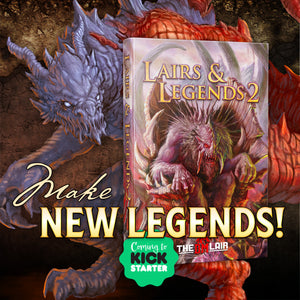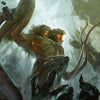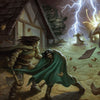The Three Pillars of Play in D&D

Written by Luke Hart
If you’re a dungeon master, odds are you’ve had this thought at least once: “I want my game to be fun, but I’m just not sure what to focus on.” You’re not alone. Most of us, even after years behind the screen, still worry about whether our players are having a good time. But here’s the good news: Dungeons & Dragons gives us a built-in structure for creating engaging, well-rounded games—and it’s known as the Three Pillars of Play.
These pillars—social interaction, combat, and exploration—form the backbone of fun, immersive D&D gameplay. Understanding each one and learning how to implement them in your sessions can transform your game. Let’s break each one down, explore why it’s important, and talk about how to use it well.
By the way, if you're looking for a low level pre-made adventure module for your D&D 5e game, I highly recommend Into the Fey. It's designed for levels 1 to 5, features tricksy fey and their sly schemes, and contains everything you need to play!
Watch or listen to this article by clicking the video below.
Social Interactions: Talky-Talky Done Right
You’ve probably heard someone say, “I love the roleplaying part of D&D.” And nine times out of ten, what they’re really talking about is social interaction: conversations between player characters (PCs) and non-player characters (NPCs). Maybe Jim Bob is trying to buy plate mail from Sally the Armorer, or Barbara the Bard is negotiating payment from a shady quest giver. These moments are social interactions, and they don’t have to involve funny voices or improv theater—though they certainly can.
Social interaction especially appeals to "thespian players," folks who get into character and thrive on dialogue. But even if your group isn’t packed with aspiring voice actors, chances are most of your players still enjoy bantering with an NPC or roasting the noble with the unpronounceable name. These interactions allow players to feel clever, persuasive, heroic—or just plain funny.
How do you implement this well? The biggest mistake I see is confining social interactions strictly to “town time.” Once players enter a dungeon, many DMs cut the talky-talky and shift to full-on stabby-stabby. That’s a shame. Even in dungeons, opportunities for conversation abound: maybe the goblin cooks don’t want to fight, or the enemy commander tries to talk during battle. I intentionally include at least one or two potential social encounters in every dungeon I design. And yes, monsters can talk during combat. Just a few lines each round keeps things dynamic and layered.
The flip side mistake is designing entire campaigns around nothing but social interaction. Some groups try to imitate streamed games like Critical Role, which feature a lot of talking. But what works for a scripted or professional game might not work for your group. Also, let’s be honest—social interaction-heavy sessions are just easier to run. You can fill hours with improv dialogue and a few NPCs, but a good dungeon crawl or exploration puzzle takes way more prep. So, don’t fall into the trap of taking the easy route at the expense of variety.
And one last thing: can we all stop calling social interaction “roleplaying”? The entire game is roleplaying. Casting a fireball because you’re a wizard? That’s roleplaying. Disarming a trap because you’re the rogue? Still roleplaying. Talking in a funny accent? Yes, that’s roleplaying too. But social interaction is just one part of roleplaying. Call it what it is. Or better yet, call it “talky-talky.” That works too.
Combat: More Than Just Murderhobos
Let’s not pretend otherwise: combat is a major part of D&D. It’s what happens when negotiations fail—or when players just get bored and decide the orcs deserve a beatdown. And while combat might be the most mechanically supported part of the game (90% of the Player’s Handbook is dedicated to it), it also taps into something primal: the thrill of power, victory, and solving tactical problems under pressure.
Combat appeals to players for all sorts of reasons. It’s a power fantasy. You’re not stuck at your day job—you’re swinging a warhammer at a hobgoblin’s face. You’re not dealing with spreadsheets—you’re casting Fireball and laughing maniacally. Combat also brings structure. It’s a chess match with fire and swords. Tactical players thrive on positioning, spell choices, and synergizing with allies. It can be just as much about smarts as it is about smashing things.
What’s the downside? Like with social interaction, the problem comes when combat dominates your game. A D&D session that’s 100% fighting can quickly become exhausting. High-intensity combat back to back will burn your players out—even the ones who love it. So give them a breather. Let them talk to someone. Let them explore. Let them snack, joke, or just soak in the story.
Also, don’t feel like every combat encounter has to start with initiative. Begin with dialogue. Let the enemy talk. Maybe your players don’t want to fight. Let them decide if things get bloody. That moment of hesitation—of decision—can be more powerful than any swing of a sword.
Exploration: The Forgotten Pillar
Let’s clear this up right now: exploration is not just travel. Walking from town to dungeon isn’t exploration. That’s travel. Exploration is what happens inside the dungeon, inside the haunted mansion, inside the abandoned sewer. It’s the act of players using their characters to interact with the environment in meaningful ways—searching for traps, analyzing a mysterious rune, checking the chest for a false bottom.
The fun of exploration comes from mystery, suspense, and payoff. There’s tension in wondering, Is that wall hiding something? There’s satisfaction in disarming a trap or discovering a shortcut. Sure, some of it might feel slow or cautious—players poking around endlessly—but the thrill of finally uncovering a secret room or snagging that bonus magic item makes it all worth it.
How do you implement it? Think beyond just “roll Perception.” Build dungeons that have things to find. Add secret doors, hidden compartments, dangerous puzzles, and obscure clues. Include alternative paths and optional areas. Drop little tidbits of lore that curious players can piece together. Most importantly, include rewards for exploring: magical items, story reveals, traps avoided, or encounters skipped. If there’s no payoff, players will stop trying.
The Power of Balance
Now here’s the big picture: running a great D&D game isn’t about picking your favorite pillar and sticking with it. It’s about balancing all three. A session might lean toward one pillar, sure. Maybe it’s mostly combat one week, or filled with rich social interaction the next. That’s fine. But over time, your campaign should give all three pillars their moment to shine.
Some of your players will gravitate toward combat. Others will crave exploration. And some will never be happier than when their bard is making eyes at the tavern keeper. Your job as the dungeon master is to give everyone their fun, even if it’s not your personal favorite pillar.
And hey, the best sessions? The ones your players talk about for weeks? They’re usually the ones where all three pillars are firing at once. The rogue sneaks through a trapped hallway (exploration), the group interrogates the villain’s lieutenant (social), and then the boss fight kicks off (combat). That’s the magic.
So if you’re wondering how to make your D&D game more fun—start with the pillars. Use them. Balance them. Build around them.
And maybe throw a riddle or kobold cook in your dungeon for good measure.
Confront Devious Fey and Their Tricksy Plots!
For years, the fey creatures inhabiting Pelview Grove to the north and Pelfell Bog to the east have not been a source of trouble, though perhaps they were a shade too mischievous at times. That has now changed.
Beset on all sides by a variety of issues -- childish pranks gone wild, dwarves forced out of their own brewery, and farmers missing -- the Aeredale guard is looking for help from local adventuring parties to set things right.
For those brave souls who accept the call to adventure, it'll be time to go into the fey.
If you’re looking to start up a new 5e campaign or reboot your current one, Into the Fey may be exactly what you need. Designed for levels 1 to 5, Into the Fey contains everything you need to start playing:
- Eleven fey-themed adventures for level 1 to 5 adventuring parties
- Over 40 new fey monsters
- The fully fleshed-out town of Aeredale
- Maps of Aeredale, the surrounding region, and the Fey Plane
- Player handouts
- Hag potion system
- 15 new fey magic items
- JPG image files of all Into the Fey adventure maps, including GM versions and gridded/non-gridded player versions
- JPG images files of all Into the Fey world maps
- Digital tokens of Into the Fey NPCs and monsters
Pick up the Into the Fey Ultimate Bundle to get the hardcover, the PDF, digital maps, and digital tokens.
Starting a new campaign can be tons of work; let Into the Fey do some of the heavy lifting for you!
-
Posted in
Game Master How-To Articles







